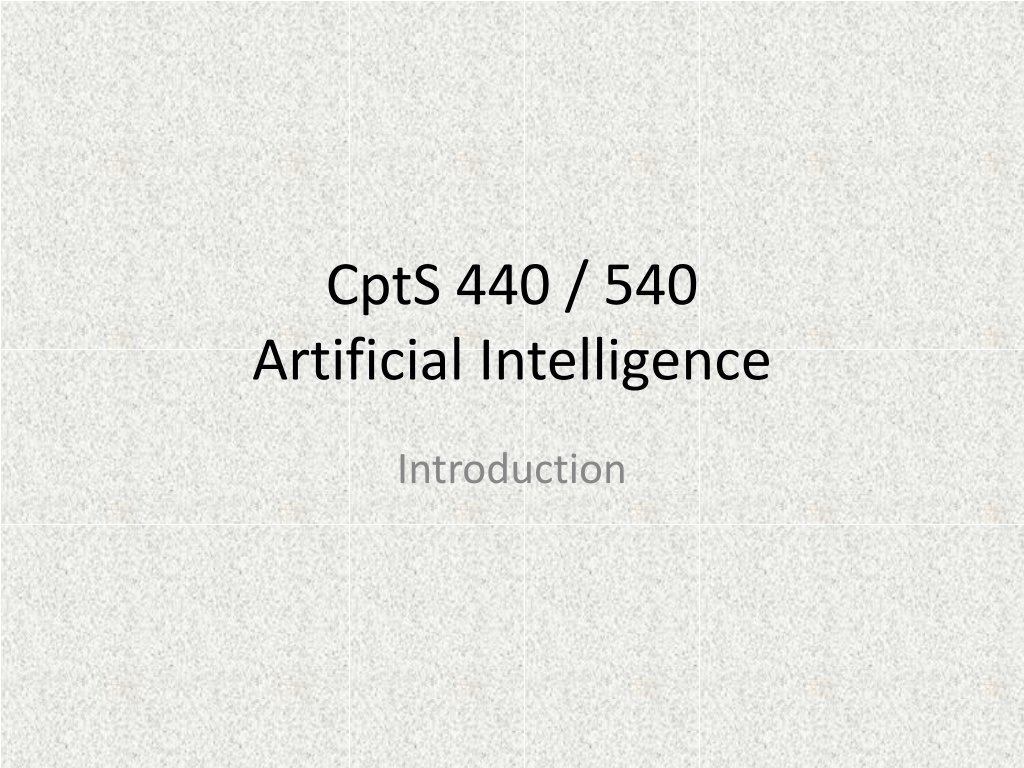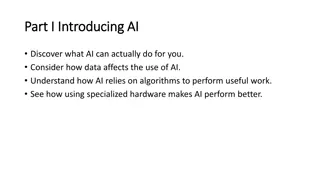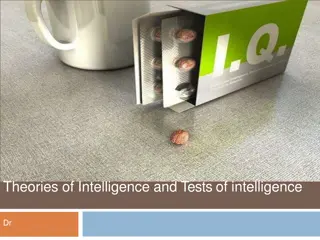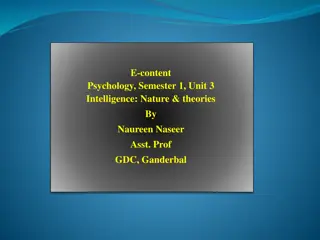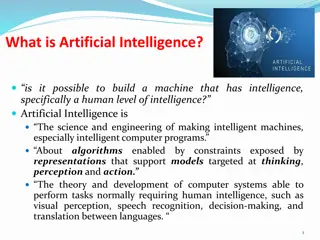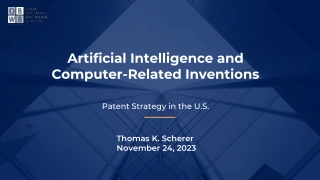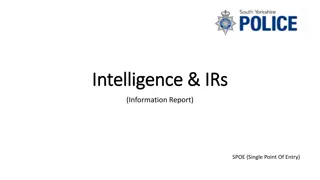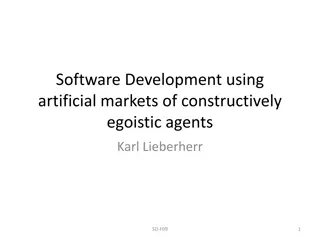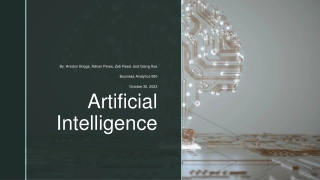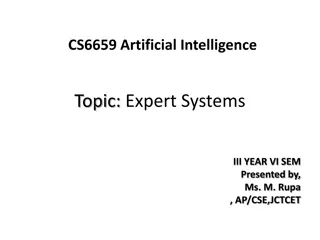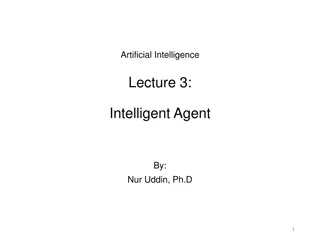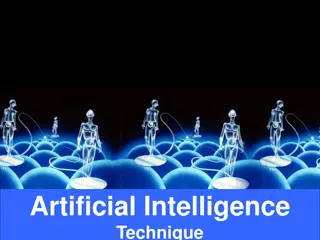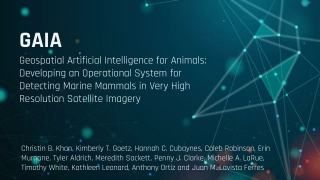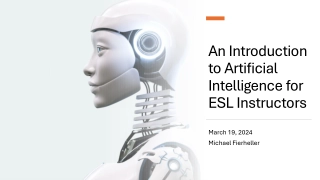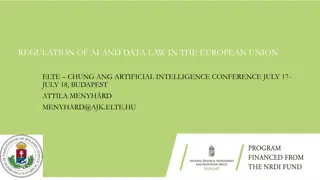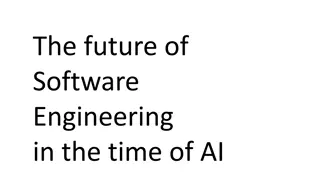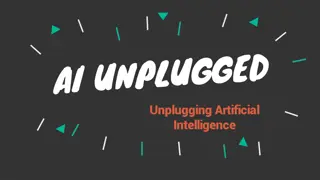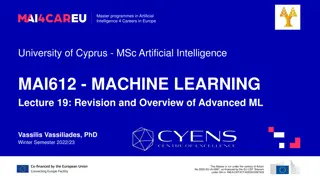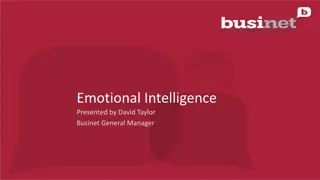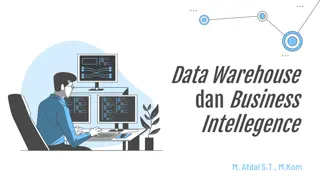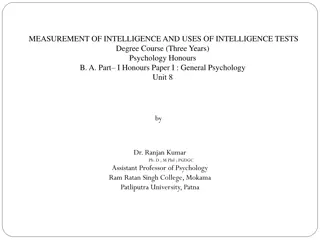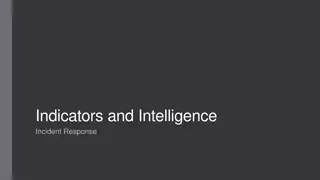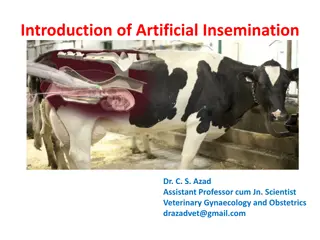Understanding Artificial Intelligence: A Comprehensive Overview
Exploring the essence of Artificial Intelligence (AI), this content delves into the significance of studying AI, its potential impact on civilization, and various definitions provided by experts in the field. From systems that think like humans to intelligent computer programs, AI continues to shape the future across multiple disciplines.
Download Presentation

Please find below an Image/Link to download the presentation.
The content on the website is provided AS IS for your information and personal use only. It may not be sold, licensed, or shared on other websites without obtaining consent from the author. Download presentation by click this link. If you encounter any issues during the download, it is possible that the publisher has removed the file from their server.
E N D
Presentation Transcript
CptS 440 / 540 Artificial Intelligence Introduction
Why Study AI? AI makes computers more useful Intelligent computer would have huge impact on civilization AI cited as field I would most like to be in by scientists in all fields Computer is a good metaphor for talking and thinking about intelligence
Why Study AI? Turning theory into working programs forces us to work out the details AI yields good results for Computer Science AI yields good results for other fields Computers make good experimental subjects Personal motivation: mystery
What is the definition of AI? What do you think?
What is the definition of AI? Systems that think like humans Systems that act like humans Systems that think rationally Systems that act rationally
What is the definition of AI? Systems that think like humans Systems that act like humans Systems that think rationally Systems that act rationally Bellman, 1978 [The automation of] activities that we associate with human thinking, activities such as decision making, problem solving, learning
What is the definition of AI? Systems that think like humans Systems that act like humans Systems that think rationally Systems that act rationally Charniak & McDermott, 1985 The study of mental faculties through the use of computational models
What is the definition of AI? Systems that think like humans Systems that act like humans Systems that think rationally Systems that act rationally Dean et al., 1995 The design and study of computer programs that behave intelligently. These programs are constructed to perform as would a human or an animal whose behavior we consider intelligent
What is the definition of AI? Systems that think like humans Systems that act like humans Systems that think rationally Systems that act rationally Haugeland, 1985 The exciting new effort to make computers think machines with minds, in the full and literal sense
What is the definition of AI? Systems that think like humans Systems that act like humans Systems that think rationally Systems that act rationally Kurzweil, 1990 The art of creating machines that perform functions that require intelligence when performed by people
What is the definition of AI? Systems that think like humans Systems that act like humans Systems that think rationally Systems that act rationally Luger & Stubblefield, 1993 The branch of computer science that is concerned with the automation of intelligent behavior
What is the definition of AI? Systems that think like humans Systems that act like humans Systems that think rationally Systems that act rationally Nilsson, 1998 Many human mental activities such as writing computer programs, doing mathematics, engaging in common sense reasoning, understanding language, and even driving an automobile, are said to demand intelligence. We might say that [these systems] exhibit artificial intelligence
What is the definition of AI? Systems that think like humans Systems that act like humans Systems that think rationally Systems that act rationally Rich & Knight, 1991 The study of how to make computers do things at which, at the moment, people are better
What is the definition of AI? Systems that think like humans Systems that act like humans Systems that think rationally Systems that act rationally Schalkoff, 1990 A field of study that seeks to explain and emulate intelligent behavior in terms of computational processes
What is the definition of AI? Systems that think like humans Systems that act like humans Systems that think rationally Systems that act rationally Winston, 1992 The study of the computations that make it possible to perceive, reason, and act
Approach 1: Acting Humanly Turing test: ultimate test for acting humanly Computer and human both interrogated by judge Computer passes test if judge can t tell the difference
How effective is this test? Agent must: Have command of language Have wide range of knowledge Demonstrate human traits (humor, emotion) Be able to reason Be able to learn Loebner prize competition is modern version of Turing Test Example: Alice, Loebner prize winner for 2000 and 2001
Chinese Room Argument Imagine you are sitting in a room with a library of rule books, a bunch of blank exercise books, and a lot of writing utensils. Your only contact with the external world is through two slots in the wall labeled ``input'' and ``output''. Occasionally, pieces of paper with Chinese characters come into your room through the ``input'' slot. Each time a piece of paper comes in through the input slot your task is to find the section in the rule books that matches the pattern of Chinese characters on the piece of paper. The rule book will tell you which pattern of characters to inscribe the appropriate pattern on a blank piece of paper. Once you have inscribed the appropriate pattern according to the rule book your task is simply to push it out the output slot. By the way, you don't understand Chinese, nor are you aware that the symbols that you are manipulating are Chinese symbols. In fact, the Chinese characters which you have been receiving as input have been questions about a story and the output you have been producing has been the appropriate, perhaps even "insightful," responses to the questions asked. Indeed, to the outside questioners your output has been so good that they are convinced that whoever (or whatever) has been producing the responses to their queries must be a native speaker of, or at least extremely fluent in, Chinese.
Do you understand Chinese? Searle says NO What do you think? Is this a refutation of the possibility of AI? The Systems Reply The individual is just part of the overall system, which does understand Chinese The Robot Reply Put same capabilities in a robot along with perceiving, talking, etc. This agent would seem to have genuine understanding and mental states.
Approach 2: Thinking Humanly Requires knowledge of brain function What level of abstraction? How can we validate this This is the focus of Cognitive Science
Approach 3: Thinking Rationally Aristotle attempted this What are correct arguments or thought processes? Provided foundation of much of AI Not all intelligent behavior controlled by logic What is our goal? What is the purpose of thinking?
Approach 4: Acting Rationally Act to achieve goals, given set of beliefs Rational behavior is doing the right thing Thing which expects to maximize goal achievement This is approach adopted by Russell & Norvig
Foundations of AI Philosophy 450 BC, Socrates asked for algorithm to distinguish pious from non- pious individuals Aristotle developed laws for reasoning Mathematics 1847, Boole introduced formal language for making logical inference Economics 1776, Smith views economies as consisting of agents maximizing their own well being (payoff) Neuroscience 1861, Study how brains process information Psychology 1879, Cognitive psychology initiated Linguistics 1957, Skinner studied behaviorist approach to language learning
History of AI CS-based AI started with Dartmouth Conference in 1956 Attendees John McCarthy LISP, application of logic to reasoning Marvin Minsky Popularized neural networks Slots and frames The Society of the Mind Claude Shannon Computer checkers Information theory Open-loop 5-ball juggling Allen Newell and Herb Simon General Problem Solver
AI Questions Can we make something that is as intelligent as a human? Can we make something that is as intelligent as a bee? Can we make something that is evolutionary, self improving, autonomous, and flexible? Can we save this plant $20M/year by pattern recognition? Can we save this bank $50M/year by automatic fraud detection? Can we start a new industry of handwriting recognition agents?
Which of these exhibits intelligence? You beat somebody at chess. You prove a mathematical theorem using a set of known axioms. You need to buy some supplies, meet three different colleagues, return books to the library, and exercise. You plan your day in such a way that everything is achieved in an efficient manner. You are a lawyer who is asked to defend someone. You recall three similar cases in which the defendant was guilty, and you turn down the potential client. A stranger passing you on the street notices your watch and asks, Can you tell me the time? You say, It is 3:00. You are told to find a large Phillips screwdriver in a cluttered workroom. You enter the room (you have never been there before), search without falling over objects, and eventually find the screwdriver.
Which of these exhibits intelligence? You are a six-month-old infant. You can produce sounds with your vocal organs, and you can hear speech sounds around you, but you do not know how to make the sounds you are hearing. In the next year, you figure out what the sounds of your parents' language are and how to make them. You are a one-year-old child learning Arabic. You hear strings of sounds and figure out that they are associated with particular meanings in the world. Within two years, you learn how to segment the strings into meaningful parts and produce your own words and sentences. Someone taps a rhythm, and you are able to beat along with it and to continue it even after it stops. You are some sort of primitive invertebrate. You know nothing about how to move about in your world, only that you need to find food and keep from bumping into walls. After lots of reinforcement and punishment, you get around just fine.
Which of these can currently be done? Play a decent game of table tennis Drive autonomously along a curving mountain road Drive autonomously in the center of Cairo Play a decent game of bridge Discover and prove a new mathematical theorem Write an intentionally funny story Give competent legal advice in a specialized area of law Translate spoken English into spoken Swedish in real time Plan schedule of operations for a NASA spacecraft Defeat the world champion in chess
Components of an AI System An agent perceives its environment through sensors and acts on the environment through actuators. Human: sensors are eyes, ears, actuators (effectors) are hands, legs, mouth. Robot: sensors are cameras, sonar, lasers, ladar, bump, effectors are grippers, manipulators, motors The agent s behavior is described by its function that maps percept to action.
Rationality A rational agent does the right thing (what is this?) A fixed performance measure evaluates the sequence of observed action effects on the environment
PEAS Use PEAS to describe task Performance measure Environment Actuators Sensors
PEAS Use PEAS to describe task environment Performance measure Environment Actuators Sensors Example: Taxi driver Performance measure: safe, fast, comfortable (maximize profits) Environment: roads, other traffic, pedestrians, customers Actuators: steering, accelerator, brake, signal, horn Sensors: cameras, sonar, speedometer, GPS, odometer, accelerometer, engine sensors
Environment Properties Fully observable vs. partially observable Deterministic vs. stochastic / strategic Episodic vs. sequential Static vs. dynamic Discrete vs. continuous Single agent vs. multiagent
Environment Examples Environment Obser vable Determi nistic Episodic Static Discrete Agents Chess with a clock Chess without a clock Fully observable vs. partially observable Deterministic vs. stochastic / strategic Episodic vs. sequential Static vs. dynamic Discrete vs. continuous Single agent vs. multiagent
Environment Examples Environment Obser vable Determi nistic Episodic Static Discrete Agents Chess with a clock Fully Strategic Sequential Semi Discrete Multi Chess without a clock Fully Strategic Sequential Static Discrete Multi Fully observable vs. partially observable Deterministic vs. stochastic / strategic Episodic vs. sequential Static vs. dynamic Discrete vs. continuous Single agent vs. multiagent
Environment Examples Environment Obser vable Determi nistic Episodic Static Discrete Agents Chess with a clock Fully Strategic Sequential Semi Discrete Multi Chess without a clock Fully Strategic Sequential Static Discrete Multi Poker Fully observable vs. partially observable Deterministic vs. stochastic / strategic Episodic vs. sequential Static vs. dynamic Discrete vs. continuous Single agent vs. multiagent
Environment Examples Environment Obser vable Determi nistic Episodic Static Discrete Agents Chess with a clock Fully Strategic Sequential Semi Discrete Multi Chess without a clock Fully Strategic Sequential Static Discrete Multi Poker Partial Strategic Sequential Static Discrete Multi Fully observable vs. partially observable Deterministic vs. stochastic / strategic Episodic vs. sequential Static vs. dynamic Discrete vs. continuous Single agent vs. multiagent
Environment Examples Environment Obser vable Determi nistic Episodic Static Discrete Agents Chess with a clock Fully Strategic Sequential Semi Discrete Multi Chess without a clock Fully Strategic Sequential Static Discrete Multi Poker Partial Strategic Sequential Static Discrete Multi Backgammon Fully observable vs. partially observable Deterministic vs. stochastic / strategic Episodic vs. sequential Static vs. dynamic Discrete vs. continuous Single agent vs. multiagent
Environment Examples Environment Obser vable Determi nistic Episodic Static Discrete Agents Chess with a clock Fully Strategic Sequential Semi Discrete Multi Chess without a clock Fully Strategic Sequential Static Discrete Multi Poker Partial Strategic Sequential Static Discrete Multi Backgammon Fully Stochast ic Sequential Static Discrete Multi Fully observable vs. partially observable Deterministic vs. stochastic / strategic Episodic vs. sequential Static vs. dynamic Discrete vs. continuous Single agent vs. multiagent
Environment Examples Environment Obser vable Determi nistic Episodic Static Discrete Agents Chess with a clock Fully Strategic Sequential Semi Discrete Multi Chess without a clock Fully Strategic Sequential Static Discrete Multi Poker Partial Strategic Sequential Static Discrete Multi Backgammon Fully Stochast ic Sequential Static Discrete Multi Taxi driving Partial Stochast ic Sequential Dyna mic Continu ous Multi Fully observable vs. partially observable Deterministic vs. stochastic / strategic Episodic vs. sequential Static vs. dynamic Discrete vs. continuous Single agent vs. multiagent
Environment Examples Environment Obser vable Determi nistic Episodic Static Discrete Agents Chess with a clock Fully Strategic Sequential Semi Discrete Multi Chess without a clock Fully Strategic Sequential Static Discrete Multi Poker Partial Strategic Sequential Static Discrete Multi Backgammon Fully Stochast ic Sequential Static Discrete Multi Taxi driving Partial Stochast ic Sequential Dyna mic Continu ous Multi Medical diagnosis Fully observable vs. partially observable Deterministic vs. stochastic / strategic Episodic vs. sequential Static vs. dynamic Discrete vs. continuous Single agent vs. multiagent
Environment Examples Environment Obser vable Determi nistic Episodic Static Discrete Agents Chess with a clock Fully Strategic Sequential Semi Discrete Multi Chess without a clock Fully Strategic Sequential Static Discrete Multi Poker Partial Strategic Sequential Static Discrete Multi Backgammon Fully Stochast ic Sequential Static Discrete Multi Taxi driving Partial Stochast ic Sequential Dyna mic Continu ous Multi Medical diagnosis Partial Stochast ic Episodic Static Continu ous Single Fully observable vs. partially observable Deterministic vs. stochastic / strategic Episodic vs. sequential Static vs. dynamic Discrete vs. continuous Single agent vs. multiagent
Environment Examples Environment Obser vable Determi nistic Episodic Static Discrete Agents Chess with a clock Fully Strategic Sequential Semi Discrete Multi Chess without a clock Fully Strategic Sequential Static Discrete Multi Poker Partial Strategic Sequential Static Discrete Multi Backgammon Fully Stochast ic Sequential Static Discrete Multi Taxi driving Partial Stochast ic Sequential Dyna mic Continu ous Multi Medical diagnosis Partial Stochast ic Episodic Static Continu ous Single Image analysis Fully observable vs. partially observable Deterministic vs. stochastic / strategic Episodic vs. sequential Static vs. dynamic Discrete vs. continuous Single agent vs. multiagent
Environment Examples Environment Obser vable Determi nistic Episodic Static Discrete Agents Chess with a clock Fully Strategic Sequential Semi Discrete Multi Chess without a clock Fully Strategic Sequential Static Discrete Multi Poker Partial Strategic Sequential Static Discrete Multi Backgammon Fully Stochast ic Sequential Static Discrete Multi Taxi driving Partial Stochast ic Sequential Dyna mic Continu ous Multi Fully observable vs. partially observable Medical diagnosis Partial Stochast ic Episodic Static Continu ous Single Deterministic vs. stochastic / strategic Image analysis Fully Determi nistic Episodic Semi Discrete Single Episodic vs. sequential Static vs. dynamic Discrete vs. continuous Single agent vs. multiagent
Environment Examples Environment Obser vable Determi nistic Episodic Static Discrete Agents Chess with a clock Fully Strategic Sequential Semi Discrete Multi Chess without a clock Fully Strategic Sequential Static Discrete Multi Poker Partial Strategic Sequential Static Discrete Multi Backgammon Fully Stochast ic Sequential Static Discrete Multi Taxi driving Partial Stochast ic Sequential Dyna mic Continu ous Multi Fully observable vs. partially observable Medical diagnosis Partial Stochast ic Episodic Static Continu ous Single Deterministic vs. stochastic / strategic Image analysis Fully Determi nistic Episodic Semi Discrete Single Robot part picking Episodic vs. sequential Static vs. dynamic Discrete vs. continuous Single agent vs. multiagent
Environment Examples Environment Obser vable Determi nistic Episodic Static Discrete Agents Chess with a clock Fully Strategic Sequential Semi Discrete Multi Chess without a clock Fully Strategic Sequential Static Discrete Multi Poker Partial Strategic Sequential Static Discrete Multi Backgammon Fully Stochast ic Sequential Static Discrete Multi Taxi driving Partial Stochast ic Sequential Dyna mic Continu ous Multi Fully observable vs. partially observable Medical diagnosis Partial Stochast ic Episodic Static Continu ous Single Deterministic vs. stochastic / strategic Image analysis Fully Determi nistic Episodic Semi Discrete Single Robot part picking Fully Determi nistic Episodic Semi Discrete Single Episodic vs. sequential Static vs. dynamic Discrete vs. continuous Single agent vs. multiagent
Environment Examples Environment Obser vable Determi nistic Episodic Static Discrete Agents Chess with a clock Fully Strategic Sequential Semi Discrete Multi Chess without a clock Fully Strategic Sequential Static Discrete Multi Poker Partial Strategic Sequential Static Discrete Multi Backgammon Fully Stochast ic Sequential Static Discrete Multi Taxi driving Partial Stochast ic Sequential Dyna mic Continu ous Multi Fully observable vs. partially observable Medical diagnosis Partial Stochast ic Episodic Static Continu ous Single Deterministic vs. stochastic / strategic Image analysis Fully Determi nistic Episodic Semi Discrete Single Robot part picking Fully Determi nistic Episodic Semi Discrete Single Episodic vs. sequential Static vs. dynamic Interactive English tutor Discrete vs. continuous Single agent vs. multiagent
Environment Examples Environment Obser vable Determi nistic Episodic Static Discrete Agents Chess with a clock Fully Strategic Sequential Semi Discrete Multi Chess without a clock Fully Strategic Sequential Static Discrete Multi Poker Partial Strategic Sequential Static Discrete Multi Backgammon Fully Stochast ic Sequential Static Discrete Multi Taxi driving Partial Stochast ic Sequential Dyna mic Continu ous Multi Fully observable vs. partially observable Medical diagnosis Partial Stochast ic Episodic Static Continu ous Single Deterministic vs. stochastic / strategic Image analysis Fully Determi nistic Episodic Semi Discrete Single Robot part picking Fully Determi nistic Episodic Semi Discrete Single Episodic vs. sequential Static vs. dynamic Interactive English tutor Partial Stochast ic Sequential Dyna mic Discrete Multi Discrete vs. continuous Single agent vs. multiagent
Agent Types Types of agents (increasing in generality and ability to handle complex environments) Simple reflex agents Reflex agents with state Goal-based agents Utility-based agents Learning agent
Simple Reflex Agent Use simple if then rules Can be short sighted SimpleReflexAgent(percept) state = InterpretInput(percept) rule = RuleMatch(state, rules) action = RuleAction(rule) Return action
